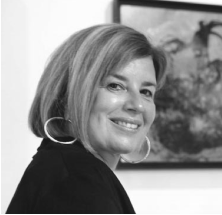Biography

Brazilian artist Christina Oiticica was born in Rio de Janeiro, on November 23rd 1951. She lived in Rio de Janeiro until 2003 when, after many trips to Europe, she decided to divide her time between the Pyrenees mountain in south-western France and Rio de Janeiro. In France, Christina’s work developed to become a partnership with nature. This happened by chance when she was preparing large canvases for an exhibition. Christina and Paulo rented a small room in a simple hotel at the time. The room was not large enough for Christina to work in so she went outside to paint and left the canvases outside to dry overnight. When she returned the next day, she saw that leaves, twigs and bugs had fallen onto the canvas. She loved the effect of nature’s work and decided to leave it, and only added her finishing touches. Thus was born Christina’s partnership with nature, present in most of her work. She leaves her work in forests, river beds, inside trees, buried in the soil, etc. After nature has done its work on Christina’s work, she will finish it.
“I like to portray in my work, in a simple and direct way, the world, the present moment, and the society in which we live. That was how my first exhibition emerged, work based on the visual impressions of my pilgrimage along the Path to Santiago de Compostela, in July/August 1990. In mounting the show, at the Casa de España, in Rio de Janeiro, I tried to arrange the room in such a way that visitors not only observed the themes of the paintings, but also might experience a symbolic journey along the Holy Way”.
“The same thing happened with the exhibition “Anjos” (Angels), in 1994, at the Centro Cultural da Light, in Rio de Janeiro. Based on one of the most ancient archetypal forms of contact with divinity – the angel - I showed beings as they are usually depicted in the popular imagination (and, consequently, in my own imagination)”.
“In the exhibition “Joana D’Arc” (Joan of Arc), in 1996 at the Casa França-Brasil, also in Rio de Janeiro, I portrayed the woman warrior, through feminine tenderness and the tenacity of women at work. Although I explored the mythical figure of the French heroine, I also drew upon great women of our time (such as Mother Teresa of Calcutta) and the anonymous and valiant warriors of everyday life (black women from the favela, Islamic women, Indians, Geishas, etc.). In each I placed some detail that represented Joan of Arc, the original model: part of her armour, a spear, a sword, but I also emphasised what really exists behind the steel and the breastplate – the feminine essence”.
“At the Museu Nacional de Belas Artes, in 1997, my theme was a reflection of the previous show. I worked with details of women’s bodies (in the age from 12 to 90), captured during small moments of everyday life, such as a hand praying with beads, the foot of a ballet dancer as she puts on her slippers, a bust reflected in the mirror …, small gestures which represent great gestures and help us to face the good fight every day”.
“During this phase in my work I dived into the figurative world and moved towards monochrome. Although I had always used much colour in my work, I thought that this time, the human body, so suavely portrayed on a canvas, should be completed by the eye of the viewer, that wouldn’t just complement the figure, but also stamp on it the colour in his or her soul”.
“In my next works, shown at the Galeria Portal, in São Paulo, in 1998, and in 1999 at the gallery of Centro Cultural Cândido Mendes, I deliberately sought to innovate, and even take risks. Still using the female body as my theme, I submitted my drawings to computer technology in order to reinvent textures, dissolve images, bend and distort objects; I mixed breasts and pearls and recreated a third form… blended and unified. Using the images I obtained, I developed works on canvas, showing that the female body, the beautiful and the sacred can have the same form”.
“I currently see art as a path for research, one of the roads leading to the discovery of truth and beauty. I also perceive that beauty is not only to be found in the fine brushstroke of the artist, it is present in the various languages that translate art. The installations that today fill my work, reveal in the symbol of the object as art, the beauty of feminine divinity in all its facets – sexuality, fecundity, maternity and life”.

